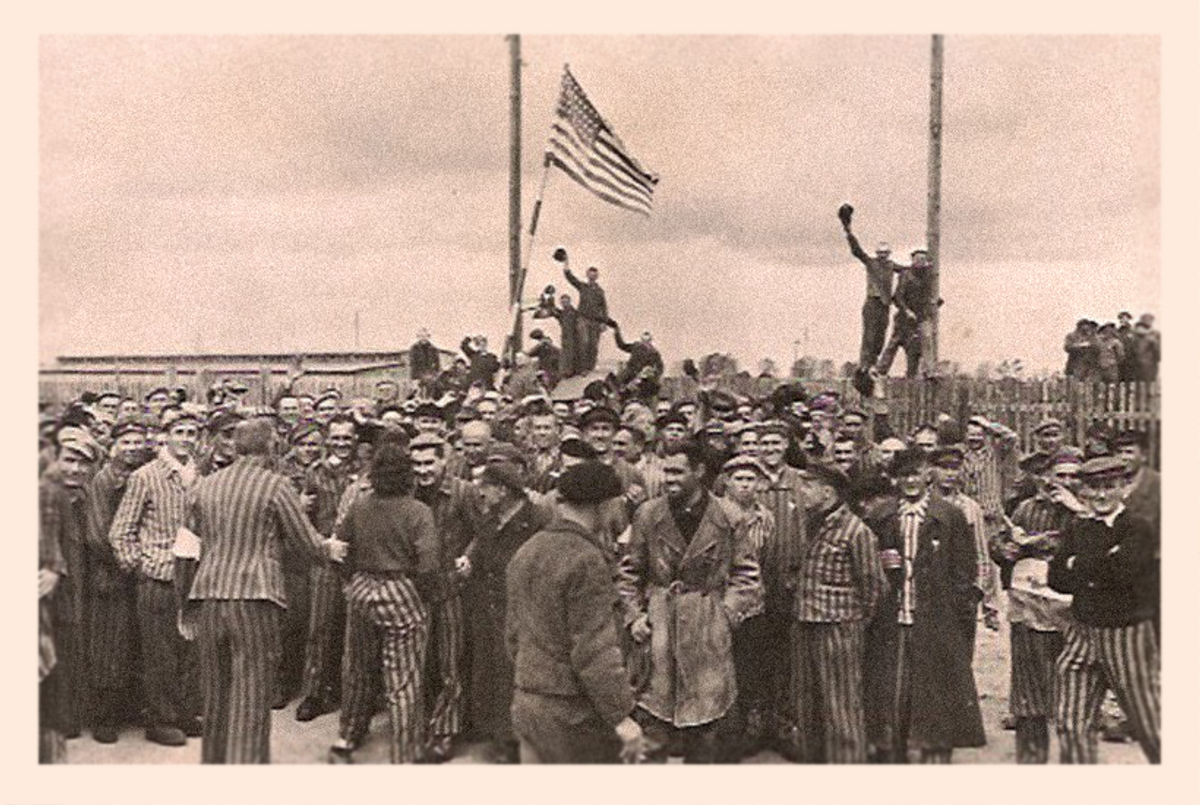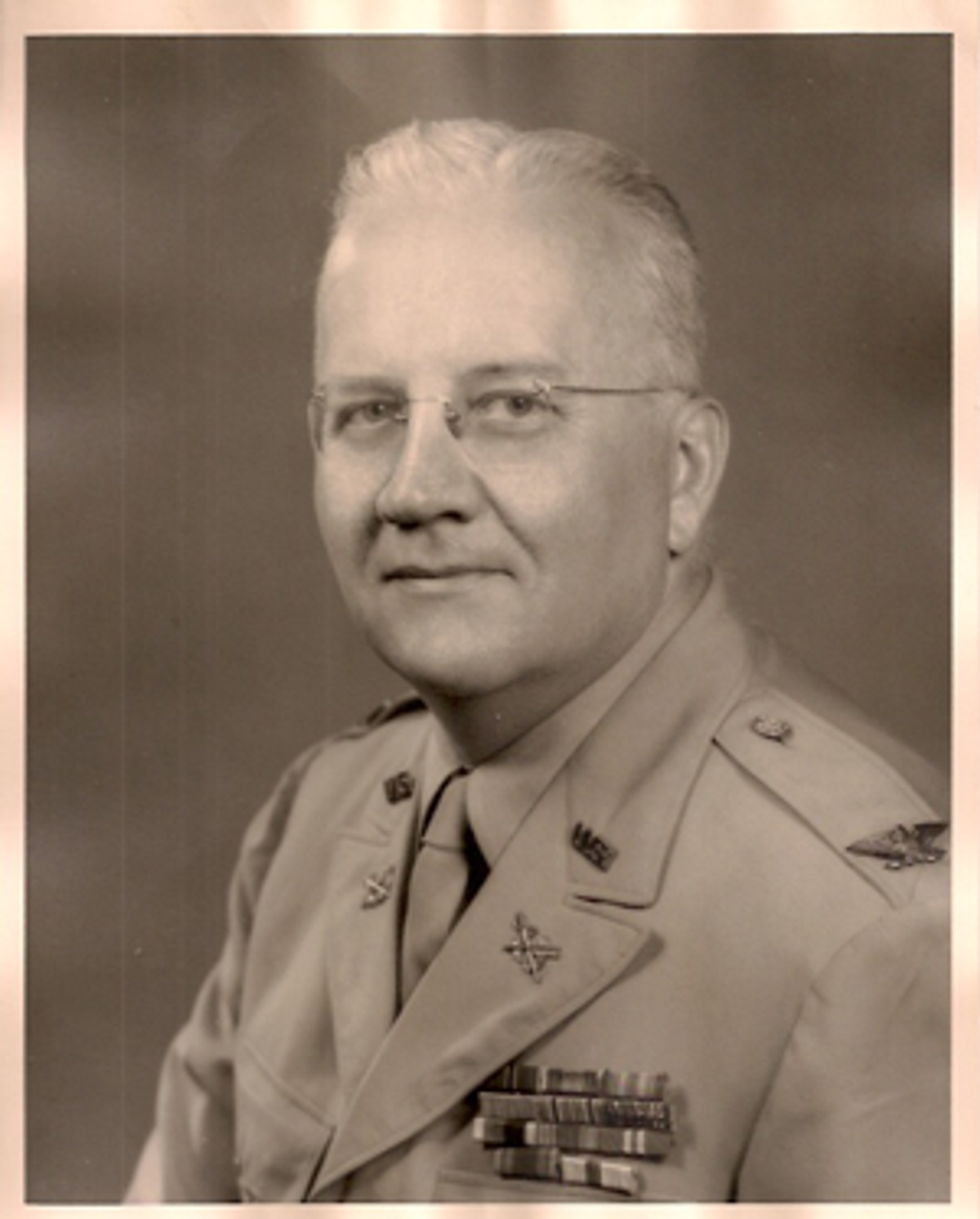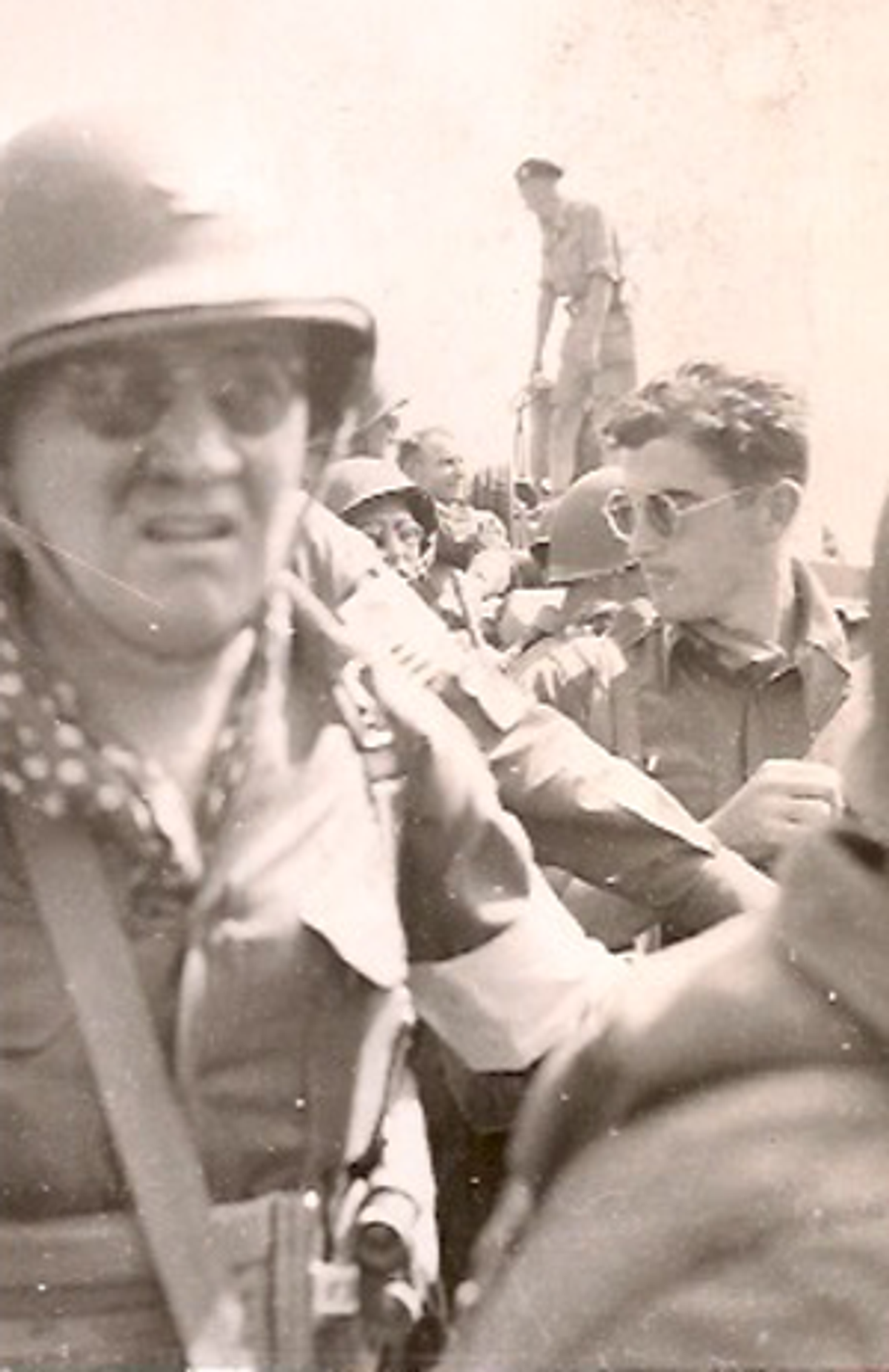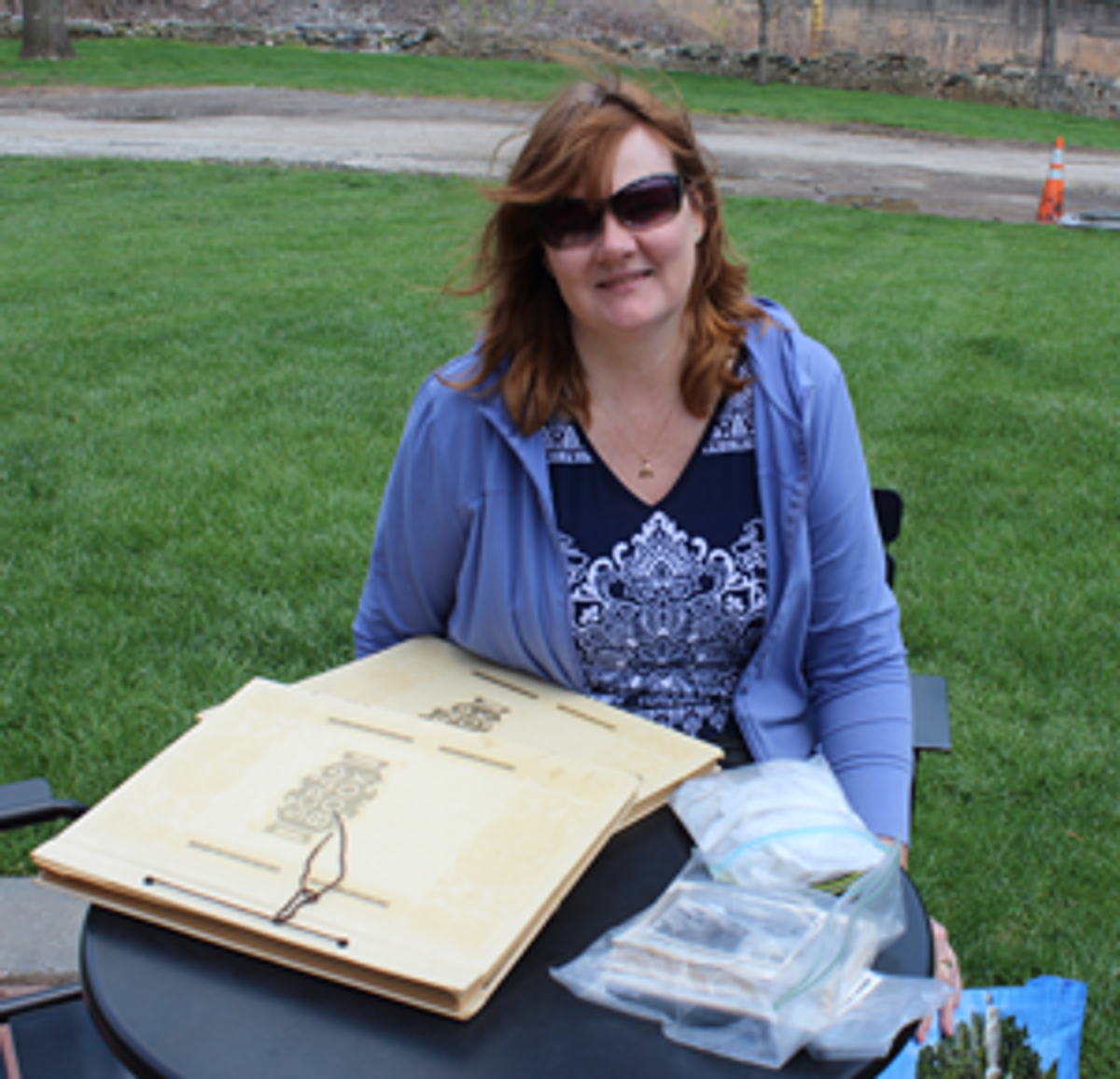
It was about 40 years ago, and Bernadette O’Connell was 11 and watching the television program Hogan’s Heroes with her brother in the family’s Potomac, Maryland, home, when their grandfather, Pinckney Glasgow McElwee, went ballistic.
“‘This is not the way it was,’” O’Connell, 52, remembered him screaming. “‘I can’t believe they’re making a comedy about concentration camps.’”
“He was shaking out of control,” O’Connell said. “It was very impressive, because he never spoke about it.”
By “it,” O’Connell meant McElwee’s service in WWII. A colonel in the Judge Advocate General’s Corps, he served in the Seventh U.S. Army and was there when the Americans liberated the Nazis’ concentration camp at Dachau, Germany, on April 29, 1945.
Her grandfather never spoke about his service, but he did take pictures. And now, the approach of the 70th anniversary of the liberation of Dachau has moved O’Connell to donate to the U.S. Holocaust Memorial Museum the three small photographs McElwee snapped of the horrific scenes he witnessed that day, along with his 41 5” x 7” prints made by photographers with the U.S. Army’s Signal Corps of the liberations of Dachau and its sub-camp at Landsberg.
The pictures had long lived where McElwee pasted them, on 15 pages at the back of one of two large scrapbooks with ivory-colored covers that he’d kept to document his WWII service. The Holocaust images were kept apart so they wouldn’t easily be seen, O’Connell thinks. O’Connell long ago removed the pictures from the pages and keeps them elsewhere.
Ever since inheriting the scrapbooks upon her father’s death, O’Connell intended to donate the Holocaust photographs to a proper repository. She’d considered the Dachau site’s museum or the Palace of Justice in Nuremberg, where war-crimes trials of Nazi officials were held in 1945 and 1946 and where she has always believed her grandfather also played a role—evidently in the gathering of evidence. In testimony on April 14, 1947, before the House Armed Services Committee, McElwee mentioned only his having been “in charge of a war-crime investigation in Germany” and the difficulty in taking “the testimony of witnesses who were just going and coming.” A photograph pasted in the scrapbook shows McElwee standing before a door marked Judge Advocate Section, War Crimes.
But four years ago, a non-Jewish friend steered O’Connell, raised Catholic and now a member of a non-denominational church, away from those options. Entrusting her heirlooms to a Jewish institution, the friend argued, would better assure that the Holocaust could never be denied.
“‘I don’t want that to happen, so let me choose more wisely,’” O’Connell said she told herself.
On April 21, I met O’Connell at a coffee shop, where she explained that Yom HaShoah the previous week provided her with the ultimate push to finally donate the photographs, and to make the Holocaust museum, which she’s visited one time, their keeper. Then, two days later, I drove to her stone house in Baltimore’s Parkville neighborhood. It’s a neighborhood of snug residences built for soldiers returning from WWII. A Veterans of Foreign Wars post sits nine blocks away. Judith Cohen, the director of the Washington museum’s photographic reference section, was there to see the photographs and hear about McElwee.
***

O’Connell doesn’t know much about what McElwee saw and did at Landsberg, Dachau, Nuremberg, and elsewhere in Germany. Her grandfather died in 1975, not long after his Hogan’s Heroes outburst. Her father, Eugene, died in 2001. Both McElwees and their wives are buried at Arlington National Cemetery. “They never talked about it,” she said of attempts to gain information from her father about his father’s service.
Visiting, too, was O’Connell’s friend Linda Minichiello, whose uncle spent nearly three years in Dachau as a political prisoner. Minichiello will be visiting her uncle, 96-year-old Willy Mathieson, in May in their native Norway, perhaps for the last time, hoping to get him to reveal some of what he endured in the camp.
Cohen was eager to glean information from both women. A report her museum prepared a few years back identified gaps in its collection, including, she said, the documentation of the experiences of non-Jewish political prisoners during the Holocaust. At O’Connell’s home, Cohen reached for a pile of O’Connell’s Signal Corps photographs taken at Dachau’s liberation. She flipped one Signal Corps image after another back onto the coffee table, recognizing them from the museum’s approximately 100,000-item photo archive.

At one point, Cohen paused to examine a picture that she hadn’t seen before, one she might want to acquire for the museum. It showed 25 male inmates in striped uniforms standing at the edge of a dug grave. On the back, in blue-block type, appeared a caption that is Signal Corps-typical in its details. The caption stated that the prisoners are indicating where they’d been forced each day to bury fellow inmates who’d endured “the cruel treatment” and “starvation diet handed out by their German keepers.” Above the caption appeared the date of April 30, 1945, and the Signal Corps photographer’s name, Arland B. Musser; below it, the complete military attribution: 7th Army, XV Corps, 1st Battalion, 157th Infantry, 45th Division and the words Dachau, Germany. A pink stamp at the bottom affirmed that it passed through the office of the chief press censor.
Cohen put this and six other pictures she’d like to acquire into a separate pile. She was not familiar with them and wanted to check the museum’s collection to be sure.
Several Landsberg photographs also piqued her interest. Two pictures, site unstated and taken on May 12, 1945, showed a prone corpse with a bloated right cheek. The caption revealed that the man was beaten to death by the Gestapo on or about April 25; in one of the two pictures, a snapshot appeared upon the man’s right shoulder. The snapshot helped in making a positive identification of the victim: Robert Moser, a former member of the Austrian underground.

Cohen was stunned by the two Moser pictures and by several others she hadn’t seen before, ones she’d similarly like to acquire. She was captivated, too, by a photo showing a helmeted McElwee aboard the military’s landing craft that’s approaching southern France near St. Tropez on the morning of Aug. 16, 1944. McElwee mailed it as a postcard to his wife Eugenia, known as Jeanie, back in their native St. Louis and penned all the details, including this wry observation: “I was having a good squint at a bunch of German prisoners.”
Pink, McElwee signed it, as he did the 57 letters and aerogrammes he mailed Jeanie from Europe beginning in 1943 and that O’Connell still has. Only one item of correspondence —a letter sent from Augsburg, Germany, to his son, a high-school senior—post-dates Dachau, but McElwee didn’t write about what he’d witnessed there.
Cohen will eventually compare even the discarded images with prints the museum owns to see whether the latter contain the rich details stamped on the back of these, details that can provide invaluable context.
O’Connell was obviously pleased with Cohen’s enthusiasm, and by the assurance that her photographs had found the right home. She arranged with Cohen to transfer her collection to the museum later this spring. “I do not want to hold onto these pictures,” O’Connell said. “I’m very protective of them, but I want them to go to the right place. There’s no sense in them sitting on my shelf.”
She told Cohen, “I want you to be able to use them.”
***
This is all an unexpected outcome, in a way. O’Connell was until recently “ridiculously ignorant” of Jews, she said, having known almost none despite living in big-city Washington and now Baltimore.
But that seems unfair to herself. She has visited Israel twice, after all. During her 1999 trip, she was on an outing in Tiberias when a Palestinian suicide attacker detonated a bomb right in front of the hotel where she and her mother-in-law were staying. In Jerusalem, O’Connell placed a note in the Western Wall, praying to become pregnant. Fifteen months later, her first child, Maureen, was born; seven years after Maureen came a son, Thomas.
“Being at the Wall was life-changing. I sensed the presence of God there.” She was not, she said “surprised at all” that she soon became a mother. “My faith is very important to me. The Jewish people themselves are wonderful. Jewish people love their children. As a teacher, that’s important to me.”

O’Connell was at a loss when considering how her grandfather might have viewed the multicultural scene in her living room now: a Jewish reporter and a Jewish scholar sitting on McElwee’s red-felt parlor sofa, which O’Connell inherited, discussing him beside evidence of the family’s own American history. A portrait on a tilt-top side table shows his ancestor and namesake, Charles Cotesworth Pinckney, a South Carolina delegate to the Constitutional Convention; a photograph next to it shows O’Connell’s mother, Maureen, and other secretaries presenting a birthday cake to their then-boss, Vice President Richard Nixon.
O’Connell figured that McElwee, who maintained meticulous genealogical records and wrote several books on his roots, might applaud the value those present place on historical facts.
“He kept the scrapbooks, so he obviously did want this to be remembered somehow and not thrown out. He was probably very tormented that he saw these things” in the concentration camps, she said. “It must have been very painful for him. But he wanted to be true to history.”
***
Like this article? Sign up for our Daily Digest to get Tablet Magazine’s new content in your inbox each morning.
Hillel Kuttler, a writer and editor, can be reached at [email protected].
Hillel Kuttler, a writer and editor, can be reached at [email protected].